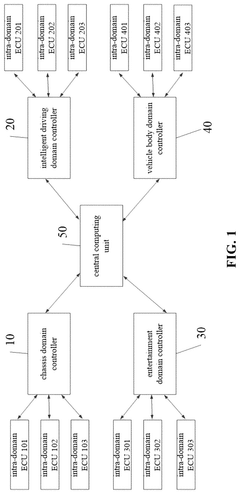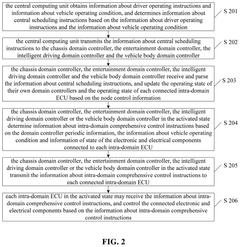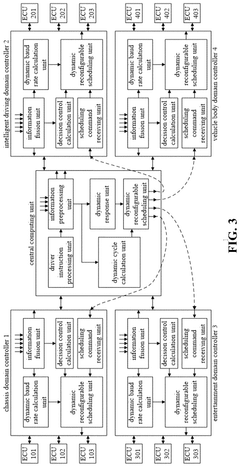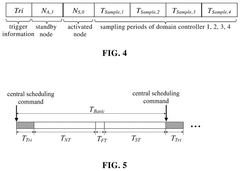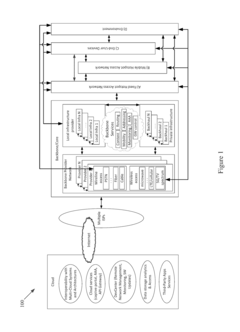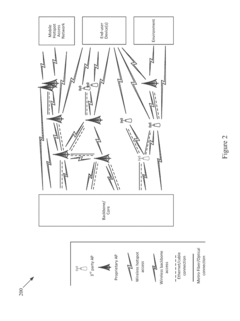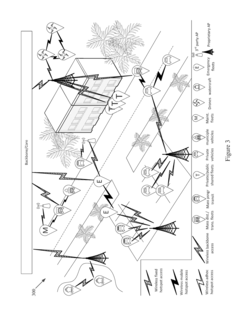Steering Wheel Technologies: Enabling Smart Transportation Networks
JUL 18, 20259 MIN READ
Generate Your Research Report Instantly with AI Agent
Patsnap Eureka helps you evaluate technical feasibility & market potential.
Smart Steering Evolution
The evolution of smart steering technologies has been a crucial component in the advancement of intelligent transportation systems. This progression can be traced through several key stages, each marked by significant technological breakthroughs and innovative solutions.
In the early 2000s, the introduction of electric power steering (EPS) systems marked the first major step towards smarter steering. EPS replaced traditional hydraulic systems with electric motors, offering improved fuel efficiency and the potential for more advanced control algorithms. This laid the foundation for future developments in steering assistance and automation.
The next significant milestone came with the integration of advanced driver assistance systems (ADAS) into steering mechanisms. Around 2010, technologies such as lane keeping assist and adaptive cruise control began to interface directly with steering systems, allowing for semi-autonomous driving capabilities. This integration represented a crucial step towards more intelligent and responsive steering control.
By the mid-2010s, steer-by-wire technology emerged as a revolutionary concept in steering design. This system eliminated the mechanical connection between the steering wheel and the wheels, replacing it with electronic controls and actuators. Steer-by-wire opened up new possibilities for customizable steering feel and enhanced vehicle dynamics control.
The late 2010s saw the rise of AI-powered steering systems. Machine learning algorithms began to be incorporated into steering control units, enabling predictive steering assistance based on driver behavior, road conditions, and environmental factors. This marked a significant leap towards truly intelligent steering systems capable of adapting to complex driving scenarios.
Most recently, the focus has shifted towards the development of steering technologies for fully autonomous vehicles. These systems are designed to operate without human input, integrating data from various sensors and making real-time decisions to navigate safely. The evolution of smart steering in this context involves sophisticated algorithms for path planning, obstacle avoidance, and vehicle dynamics optimization.
Looking ahead, the next frontier in smart steering evolution is likely to involve the integration of vehicle-to-everything (V2X) communication. This will enable steering systems to respond not only to immediate sensor data but also to information from other vehicles, infrastructure, and pedestrians, creating a more comprehensive and anticipatory steering control paradigm.
In the early 2000s, the introduction of electric power steering (EPS) systems marked the first major step towards smarter steering. EPS replaced traditional hydraulic systems with electric motors, offering improved fuel efficiency and the potential for more advanced control algorithms. This laid the foundation for future developments in steering assistance and automation.
The next significant milestone came with the integration of advanced driver assistance systems (ADAS) into steering mechanisms. Around 2010, technologies such as lane keeping assist and adaptive cruise control began to interface directly with steering systems, allowing for semi-autonomous driving capabilities. This integration represented a crucial step towards more intelligent and responsive steering control.
By the mid-2010s, steer-by-wire technology emerged as a revolutionary concept in steering design. This system eliminated the mechanical connection between the steering wheel and the wheels, replacing it with electronic controls and actuators. Steer-by-wire opened up new possibilities for customizable steering feel and enhanced vehicle dynamics control.
The late 2010s saw the rise of AI-powered steering systems. Machine learning algorithms began to be incorporated into steering control units, enabling predictive steering assistance based on driver behavior, road conditions, and environmental factors. This marked a significant leap towards truly intelligent steering systems capable of adapting to complex driving scenarios.
Most recently, the focus has shifted towards the development of steering technologies for fully autonomous vehicles. These systems are designed to operate without human input, integrating data from various sensors and making real-time decisions to navigate safely. The evolution of smart steering in this context involves sophisticated algorithms for path planning, obstacle avoidance, and vehicle dynamics optimization.
Looking ahead, the next frontier in smart steering evolution is likely to involve the integration of vehicle-to-everything (V2X) communication. This will enable steering systems to respond not only to immediate sensor data but also to information from other vehicles, infrastructure, and pedestrians, creating a more comprehensive and anticipatory steering control paradigm.
Connected Vehicle Demand
The demand for connected vehicles is rapidly growing as smart transportation networks become increasingly prevalent. This surge in demand is driven by several factors, including the need for improved road safety, enhanced traffic management, and the desire for more efficient and comfortable driving experiences. Connected vehicles, equipped with advanced communication technologies, can interact with each other and with the surrounding infrastructure, creating a dynamic and responsive transportation ecosystem.
One of the primary drivers of connected vehicle demand is the potential for significant improvements in road safety. By enabling real-time communication between vehicles and infrastructure, connected vehicle technologies can provide drivers with crucial information about road conditions, potential hazards, and traffic flow. This enhanced situational awareness can help reduce accidents and save lives. For instance, vehicle-to-vehicle (V2V) communication can alert drivers to sudden braking by vehicles ahead, even when they are not in direct line of sight.
The increasing focus on traffic management and congestion reduction is another key factor fueling the demand for connected vehicles. Smart transportation networks rely on the data collected from connected vehicles to optimize traffic flow, adjust signal timings, and provide real-time routing suggestions. This not only helps reduce travel times but also contributes to lower fuel consumption and reduced emissions, aligning with global efforts to combat climate change and improve air quality in urban areas.
Consumer demand for more convenient and personalized driving experiences is also driving the adoption of connected vehicle technologies. Features such as remote vehicle diagnostics, over-the-air software updates, and integration with smart home systems are becoming increasingly popular among car buyers. These technologies not only enhance the driving experience but also offer practical benefits such as predictive maintenance, which can help reduce vehicle downtime and maintenance costs.
The automotive industry's shift towards autonomous vehicles is another significant factor influencing the demand for connected vehicle technologies. As vehicles become more autonomous, the need for robust and reliable communication systems becomes paramount. Connected vehicle technologies serve as a crucial foundation for the development and deployment of autonomous vehicles, enabling them to navigate complex traffic scenarios and interact safely with other road users.
Government regulations and initiatives are also playing a crucial role in driving the adoption of connected vehicle technologies. Many countries are implementing policies that mandate or incentivize the inclusion of certain connected features in new vehicles, such as emergency call systems or vehicle-to-infrastructure (V2I) communication capabilities. These regulatory pushes are accelerating the market penetration of connected vehicles and fostering innovation in the sector.
One of the primary drivers of connected vehicle demand is the potential for significant improvements in road safety. By enabling real-time communication between vehicles and infrastructure, connected vehicle technologies can provide drivers with crucial information about road conditions, potential hazards, and traffic flow. This enhanced situational awareness can help reduce accidents and save lives. For instance, vehicle-to-vehicle (V2V) communication can alert drivers to sudden braking by vehicles ahead, even when they are not in direct line of sight.
The increasing focus on traffic management and congestion reduction is another key factor fueling the demand for connected vehicles. Smart transportation networks rely on the data collected from connected vehicles to optimize traffic flow, adjust signal timings, and provide real-time routing suggestions. This not only helps reduce travel times but also contributes to lower fuel consumption and reduced emissions, aligning with global efforts to combat climate change and improve air quality in urban areas.
Consumer demand for more convenient and personalized driving experiences is also driving the adoption of connected vehicle technologies. Features such as remote vehicle diagnostics, over-the-air software updates, and integration with smart home systems are becoming increasingly popular among car buyers. These technologies not only enhance the driving experience but also offer practical benefits such as predictive maintenance, which can help reduce vehicle downtime and maintenance costs.
The automotive industry's shift towards autonomous vehicles is another significant factor influencing the demand for connected vehicle technologies. As vehicles become more autonomous, the need for robust and reliable communication systems becomes paramount. Connected vehicle technologies serve as a crucial foundation for the development and deployment of autonomous vehicles, enabling them to navigate complex traffic scenarios and interact safely with other road users.
Government regulations and initiatives are also playing a crucial role in driving the adoption of connected vehicle technologies. Many countries are implementing policies that mandate or incentivize the inclusion of certain connected features in new vehicles, such as emergency call systems or vehicle-to-infrastructure (V2I) communication capabilities. These regulatory pushes are accelerating the market penetration of connected vehicles and fostering innovation in the sector.
Steering Tech Challenges
The development of smart steering wheel technologies for enabling intelligent transportation networks faces several significant challenges. These obstacles span across technical, regulatory, and user acceptance domains, requiring innovative solutions to propel the industry forward.
One of the primary technical challenges is the integration of advanced sensors and computing systems within the limited space of a steering wheel. Engineers must design compact, yet powerful systems capable of processing vast amounts of data in real-time. This includes incorporating touch-sensitive surfaces, biometric sensors, and haptic feedback mechanisms without compromising the ergonomics and safety features of traditional steering wheels.
Ensuring robust connectivity and seamless communication between the steering wheel and other vehicle systems poses another hurdle. The steering wheel must interface reliably with the vehicle's central computer, infotainment system, and external networks to enable features such as real-time traffic updates, vehicle-to-vehicle communication, and cloud-based services. This requires developing secure, low-latency communication protocols that can operate in various environmental conditions.
Power management presents a significant challenge, particularly for wireless steering wheel technologies. Balancing the need for continuous operation with the constraints of battery life and charging mechanisms is crucial. Innovative energy harvesting techniques and ultra-low-power electronics are areas of active research to address this issue.
The durability and reliability of smart steering wheel components under various environmental conditions and prolonged use is another critical concern. These systems must withstand temperature fluctuations, vibrations, and potential impacts while maintaining consistent performance throughout the vehicle's lifespan.
From a regulatory standpoint, smart steering wheels must comply with stringent safety standards and regulations. This includes ensuring that new technologies do not interfere with critical steering functions or driver attention. Developing systems that meet these requirements while still offering advanced features requires careful design and extensive testing.
User acceptance and human-machine interface (HMI) design present unique challenges. Creating intuitive, non-distracting interfaces that enhance the driving experience without overwhelming the driver is crucial. This involves extensive user testing and iterative design processes to strike the right balance between functionality and simplicity.
Lastly, cybersecurity remains a paramount concern. As steering wheels become more connected and integral to vehicle operations, they also become potential targets for cyber attacks. Developing robust security measures to protect against unauthorized access and ensure the integrity of steering systems is essential for the widespread adoption of smart steering wheel technologies.
One of the primary technical challenges is the integration of advanced sensors and computing systems within the limited space of a steering wheel. Engineers must design compact, yet powerful systems capable of processing vast amounts of data in real-time. This includes incorporating touch-sensitive surfaces, biometric sensors, and haptic feedback mechanisms without compromising the ergonomics and safety features of traditional steering wheels.
Ensuring robust connectivity and seamless communication between the steering wheel and other vehicle systems poses another hurdle. The steering wheel must interface reliably with the vehicle's central computer, infotainment system, and external networks to enable features such as real-time traffic updates, vehicle-to-vehicle communication, and cloud-based services. This requires developing secure, low-latency communication protocols that can operate in various environmental conditions.
Power management presents a significant challenge, particularly for wireless steering wheel technologies. Balancing the need for continuous operation with the constraints of battery life and charging mechanisms is crucial. Innovative energy harvesting techniques and ultra-low-power electronics are areas of active research to address this issue.
The durability and reliability of smart steering wheel components under various environmental conditions and prolonged use is another critical concern. These systems must withstand temperature fluctuations, vibrations, and potential impacts while maintaining consistent performance throughout the vehicle's lifespan.
From a regulatory standpoint, smart steering wheels must comply with stringent safety standards and regulations. This includes ensuring that new technologies do not interfere with critical steering functions or driver attention. Developing systems that meet these requirements while still offering advanced features requires careful design and extensive testing.
User acceptance and human-machine interface (HMI) design present unique challenges. Creating intuitive, non-distracting interfaces that enhance the driving experience without overwhelming the driver is crucial. This involves extensive user testing and iterative design processes to strike the right balance between functionality and simplicity.
Lastly, cybersecurity remains a paramount concern. As steering wheels become more connected and integral to vehicle operations, they also become potential targets for cyber attacks. Developing robust security measures to protect against unauthorized access and ensure the integrity of steering systems is essential for the widespread adoption of smart steering wheel technologies.
Current Smart Solutions
01 Steering wheel control systems
Advanced control systems integrated into steering wheels, including electronic controls, sensors, and interfaces for various vehicle functions. These systems enhance driver interaction, safety, and vehicle control capabilities.- Steering wheel control systems: Advanced control systems integrated into steering wheels, including electronic controls, sensors, and interfaces for various vehicle functions. These systems enhance driver interaction, safety, and vehicle control by incorporating features like adaptive steering, drive-by-wire technology, and multifunctional controls.
- Steering wheel ergonomics and adjustability: Innovations in steering wheel design focusing on ergonomics, adjustability, and comfort. This includes telescopic and tilt adjustments, customizable grips, and shape-adaptive steering wheels to accommodate different driving positions and preferences, enhancing driver comfort and control.
- Steering wheel safety features: Integration of safety technologies directly into the steering wheel, such as airbag systems, impact-absorbing materials, and collision detection sensors. These features aim to protect the driver in the event of a crash and enhance overall vehicle safety.
- Smart steering wheels with integrated displays: Development of steering wheels with integrated displays and touch-sensitive surfaces. These smart steering wheels provide real-time information, navigation assistance, and vehicle status updates directly in the driver's line of sight, improving situational awareness and reducing distraction.
- Steering wheel haptic feedback systems: Implementation of haptic feedback mechanisms in steering wheels to provide tactile alerts and information to the driver. These systems can warn of potential hazards, indicate lane departures, or provide navigation cues through vibrations or other tactile sensations in the steering wheel.
02 Steering wheel ergonomics and adjustability
Innovations in steering wheel design focusing on ergonomics, adjustability, and comfort. This includes features such as telescoping and tilting mechanisms, grip enhancements, and customizable shapes to improve driver comfort and control.Expand Specific Solutions03 Steering wheel safety technologies
Safety-enhancing technologies incorporated into steering wheels, such as airbag systems, impact-absorbing materials, and collision detection mechanisms. These innovations aim to protect drivers in the event of accidents and improve overall vehicle safety.Expand Specific Solutions04 Steering wheel-integrated display and infotainment systems
Integration of display screens, touch-sensitive surfaces, and infotainment controls directly into the steering wheel. These systems provide drivers with easy access to vehicle information, navigation, and entertainment features without taking their hands off the wheel.Expand Specific Solutions05 Steer-by-wire and autonomous driving interfaces
Advanced steering technologies that enable steer-by-wire systems and interfaces for autonomous driving modes. These innovations allow for more flexible steering control, improved vehicle dynamics, and seamless transitions between manual and autonomous driving.Expand Specific Solutions
Automotive Tech Leaders
The steering wheel technology market for smart transportation networks is in a growth phase, with increasing demand driven by the automotive industry's shift towards connected and autonomous vehicles. The market size is expanding rapidly, expected to reach several billion dollars in the coming years. Technological maturity varies, with established players like Robert Bosch GmbH, Continental Automotive GmbH, and Delphi Technology leading in advanced steering systems. Emerging companies such as BYD Co., Ltd. and Xiaomi Automobile Technology Co., Ltd. are also making significant strides in this field. Traditional automakers like Honda Motor Co., Ltd., Nissan Motor Co., Ltd., and Volkswagen AG are investing heavily in smart steering technologies to maintain their competitive edge in the evolving automotive landscape.
Honda Motor Co., Ltd.
Technical Solution: Honda has developed a steering wheel technology called "Honda Sensing 360" that contributes to smart transportation networks. This system uses a combination of cameras, millimeter-wave radar, and other sensors to provide a 360-degree sensory range around the vehicle[3]. The steering wheel is equipped with hands-on detection sensors and works in conjunction with the vehicle's autonomous driving features. Honda's technology allows for advanced driver assistance functions such as adaptive cruise control, lane keeping assist, and traffic jam assist, all of which can be controlled via the steering wheel[4]. The system is designed to seamlessly integrate with smart transportation infrastructure, enabling vehicle-to-everything (V2X) communication for improved traffic flow and safety.
Strengths: Comprehensive sensor integration, advanced driver assistance features, and V2X communication capabilities. Weaknesses: Complexity of the system may lead to higher maintenance costs and potential reliability issues.
Continental Automotive France SAS
Technical Solution: Continental has developed an innovative steering wheel technology called "Smart Control" for enabling smart transportation networks. This system integrates touch-sensitive controls and haptic feedback directly into the steering wheel, allowing drivers to control various vehicle functions without taking their hands off the wheel[1]. The technology uses capacitive touch sensors and micro-actuators to provide tactile feedback, enhancing driver safety and comfort. Continental's system also incorporates advanced driver monitoring capabilities, using infrared sensors to detect driver attentiveness and fatigue[2]. This data can be integrated into smart transportation networks to improve overall road safety and traffic management.
Strengths: Enhanced driver safety, seamless integration with vehicle systems, and potential for smart network connectivity. Weaknesses: Potential for driver distraction if not properly implemented, and higher cost compared to traditional steering wheels.
Key Steering Patents
Dynamically reconfigurable network system and network scheduling method for intelligent vehicle
PatentActiveUS20240333659A1
Innovation
- A dynamically reconfigurable network system with a central computing unit and domain controllers that dynamically activate or standby network nodes based on driver instructions and vehicle conditions, adjusting network topology and baud rates to optimize resource utilization and bandwidth.
Methods and systems for detecting anomalies and forecasting optimizations to improve smart city or region infrastructure management using networks of autonomous vehicles
PatentActiveUS20180376305A1
Innovation
- A dynamically configurable network of autonomous vehicles that utilizes a combination of fixed and mobile nodes, including Mobile Access Points (MAPs) and Fixed Access Points (FAPs), to provide robust, scalable, and secure connectivity, enabling vehicles to act as Wi-Fi hotspots and connect to both cellular networks and other vehicles, forming a mesh of communication links.
V2X Integration Outlook
The integration of Vehicle-to-Everything (V2X) communication with steering wheel technologies represents a significant advancement in smart transportation networks. This convergence enables real-time data exchange between vehicles, infrastructure, and other road users, enhancing safety, efficiency, and overall driving experience.
V2X-enabled steering wheels are poised to revolutionize the way drivers interact with their vehicles and the surrounding environment. These advanced steering systems can receive and display critical information directly on the wheel, reducing driver distraction and improving situational awareness. For instance, warnings about approaching emergency vehicles, sudden traffic congestion, or adverse weather conditions can be conveyed through haptic feedback or visual cues integrated into the steering wheel.
One of the key benefits of V2X integration in steering wheel technologies is the potential for enhanced collision avoidance. By receiving data from nearby vehicles and infrastructure, the steering system can alert drivers to potential hazards that may not be visible or immediately apparent. This could include warnings about vehicles in blind spots, pedestrians crossing at intersections, or even road surface conditions that may affect steering performance.
Furthermore, V2X-enabled steering wheels can contribute to more efficient traffic flow and reduced congestion. By receiving real-time traffic information, these systems can suggest optimal routes and driving behaviors to minimize travel time and fuel consumption. This level of connectivity also paves the way for more advanced semi-autonomous and autonomous driving features, where the steering wheel can provide intuitive handover between manual and automated driving modes.
The integration of V2X technology with steering wheels also opens up possibilities for personalized driving experiences. As vehicles become more connected, steering systems can adapt to individual driver preferences, adjusting sensitivity, feedback, and information display based on user profiles or driving conditions. This level of customization not only enhances comfort but also contributes to improved safety by tailoring the driving interface to each user's needs.
Looking ahead, the outlook for V2X integration in steering wheel technologies is promising. As smart city infrastructure expands and more vehicles become connected, the potential for seamless communication between all elements of the transportation network grows. This could lead to steering systems that not only react to immediate surroundings but also anticipate and prepare for upcoming traffic patterns, road conditions, and potential hazards well in advance.
V2X-enabled steering wheels are poised to revolutionize the way drivers interact with their vehicles and the surrounding environment. These advanced steering systems can receive and display critical information directly on the wheel, reducing driver distraction and improving situational awareness. For instance, warnings about approaching emergency vehicles, sudden traffic congestion, or adverse weather conditions can be conveyed through haptic feedback or visual cues integrated into the steering wheel.
One of the key benefits of V2X integration in steering wheel technologies is the potential for enhanced collision avoidance. By receiving data from nearby vehicles and infrastructure, the steering system can alert drivers to potential hazards that may not be visible or immediately apparent. This could include warnings about vehicles in blind spots, pedestrians crossing at intersections, or even road surface conditions that may affect steering performance.
Furthermore, V2X-enabled steering wheels can contribute to more efficient traffic flow and reduced congestion. By receiving real-time traffic information, these systems can suggest optimal routes and driving behaviors to minimize travel time and fuel consumption. This level of connectivity also paves the way for more advanced semi-autonomous and autonomous driving features, where the steering wheel can provide intuitive handover between manual and automated driving modes.
The integration of V2X technology with steering wheels also opens up possibilities for personalized driving experiences. As vehicles become more connected, steering systems can adapt to individual driver preferences, adjusting sensitivity, feedback, and information display based on user profiles or driving conditions. This level of customization not only enhances comfort but also contributes to improved safety by tailoring the driving interface to each user's needs.
Looking ahead, the outlook for V2X integration in steering wheel technologies is promising. As smart city infrastructure expands and more vehicles become connected, the potential for seamless communication between all elements of the transportation network grows. This could lead to steering systems that not only react to immediate surroundings but also anticipate and prepare for upcoming traffic patterns, road conditions, and potential hazards well in advance.
Safety & Regulatory Landscape
The safety and regulatory landscape surrounding steering wheel technologies for smart transportation networks is complex and rapidly evolving. As these technologies advance, regulatory bodies worldwide are working to establish comprehensive frameworks to ensure public safety while fostering innovation.
In the United States, the National Highway Traffic Safety Administration (NHTSA) has been at the forefront of developing guidelines for advanced driver assistance systems (ADAS) and automated driving systems (ADS). These guidelines address various aspects of steering wheel technologies, including human-machine interface design, system performance, and fail-safe mechanisms. The NHTSA's Federal Automated Vehicles Policy provides a flexible framework for the safe design, development, testing, and deployment of automated vehicles.
The European Union has also been proactive in this area, with the European Commission introducing regulations on automated lane keeping systems (ALKS) and other advanced vehicle technologies. These regulations set strict safety standards for steering wheel technologies, including requirements for driver monitoring systems and emergency maneuver capabilities.
In Asia, countries like Japan and South Korea have implemented their own regulatory frameworks. Japan's Ministry of Land, Infrastructure, Transport and Tourism has established guidelines for the testing and deployment of automated driving systems, including specific provisions for steering wheel technologies. Similarly, South Korea's Ministry of Land, Infrastructure and Transport has introduced regulations to ensure the safety and reliability of advanced vehicle technologies.
One of the key challenges in the regulatory landscape is the need to balance safety concerns with the pace of technological innovation. Regulators must ensure that safety standards are robust enough to protect the public while remaining flexible enough to accommodate rapid advancements in steering wheel technologies.
Cybersecurity is another critical aspect of the safety and regulatory landscape. As steering wheel technologies become increasingly connected and reliant on software, the risk of cyber attacks grows. Regulatory bodies are developing guidelines and standards to address these risks, such as the UN Regulation on Cybersecurity and Software Updates, which came into force in 2021.
Liability and insurance considerations also play a significant role in shaping the regulatory landscape. As steering wheel technologies become more advanced, questions arise about who is responsible in the event of an accident – the driver, the vehicle manufacturer, or the technology provider. Regulators and insurers are working to develop frameworks that address these complex liability issues.
Human-Machine Interaction (HMI) Design
In the United States, the National Highway Traffic Safety Administration (NHTSA) has been at the forefront of developing guidelines for advanced driver assistance systems (ADAS) and automated driving systems (ADS). These guidelines address various aspects of steering wheel technologies, including human-machine interface design, system performance, and fail-safe mechanisms. The NHTSA's Federal Automated Vehicles Policy provides a flexible framework for the safe design, development, testing, and deployment of automated vehicles.
The European Union has also been proactive in this area, with the European Commission introducing regulations on automated lane keeping systems (ALKS) and other advanced vehicle technologies. These regulations set strict safety standards for steering wheel technologies, including requirements for driver monitoring systems and emergency maneuver capabilities.
In Asia, countries like Japan and South Korea have implemented their own regulatory frameworks. Japan's Ministry of Land, Infrastructure, Transport and Tourism has established guidelines for the testing and deployment of automated driving systems, including specific provisions for steering wheel technologies. Similarly, South Korea's Ministry of Land, Infrastructure and Transport has introduced regulations to ensure the safety and reliability of advanced vehicle technologies.
One of the key challenges in the regulatory landscape is the need to balance safety concerns with the pace of technological innovation. Regulators must ensure that safety standards are robust enough to protect the public while remaining flexible enough to accommodate rapid advancements in steering wheel technologies.
Cybersecurity is another critical aspect of the safety and regulatory landscape. As steering wheel technologies become increasingly connected and reliant on software, the risk of cyber attacks grows. Regulatory bodies are developing guidelines and standards to address these risks, such as the UN Regulation on Cybersecurity and Software Updates, which came into force in 2021.
Liability and insurance considerations also play a significant role in shaping the regulatory landscape. As steering wheel technologies become more advanced, questions arise about who is responsible in the event of an accident – the driver, the vehicle manufacturer, or the technology provider. Regulators and insurers are working to develop frameworks that address these complex liability issues.
Human-Machine Interaction (HMI) Design
Unlock deeper insights with Patsnap Eureka Quick Research — get a full tech report to explore trends and direct your research. Try now!
Generate Your Research Report Instantly with AI Agent
Supercharge your innovation with Patsnap Eureka AI Agent Platform!
